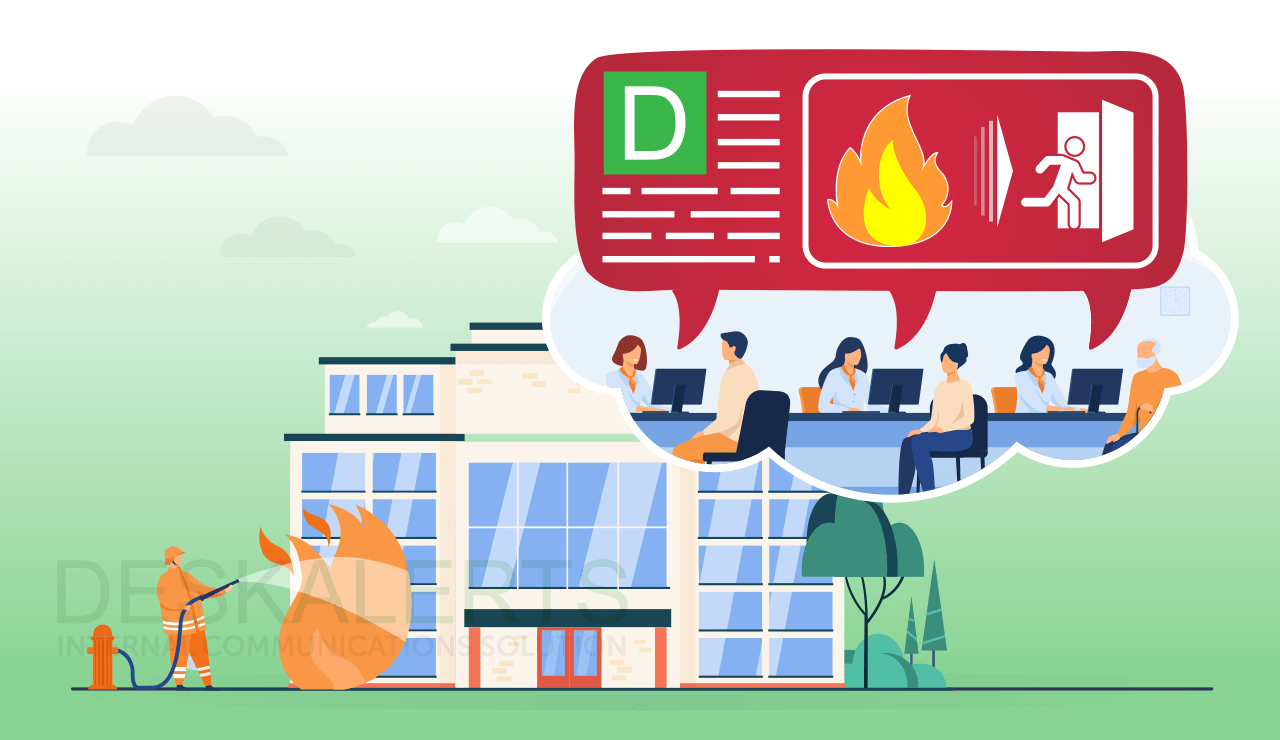
How prepared are you for an emergency in your workplace? At a minimum, you should have a fire evacuation plan in place to keep your employees safe. If you don’t have one, it isn’t too late!
What is a fire evacuation plan and why do you need one?
Emergency situations like a fire can happen when you least expect them to. A fire can break out for many different reasons: electrical wiring issues, arson, ignition as a result of an explosion, ember attack from a wildfire, just to name a few. How your organization responds to a fire can mean the difference between life and death. You may be putting your employees in danger if your business does not have a fire escape plan in place.
Fires are not a common occurrence in the workplace, but when they do occur they can be devastating to life and livelihood alike.
A fire evacuation plan is a set of protocols and procedures that employees must follow in the event of a fire. Generally, emergency evacuation plans for businesses involve employees knowing when to evacuate and how to evacuate – usually leaving the building in a calm and orderly manner and assembling for roll call in a safe outdoor place.
The exact makeup of a fire evacuation plan, however, will depend on your company’s unique logistical challenges and circumstances.
Without fire evacuation plans, businesses run the risk of their employees not knowing what to do in the event of a fire: this might mean they become trapped in a burning building and perish. As an employer, you also have legal and moral duties of care to ensure the safety and wellbeing of your employees (so-called duty of care).
>> 10 emergency notifications templates. Download for free <<
8 steps to take to create a fire evacuation plan
Every business has its own fire risks, no matter what work you do or what industry you are in. Office buildings are at risk from fire as much as laboratories and manufacturing plants.
In general, however, these are the main fire emergency procedures, step by step:
1. An overall fire evacuation strategy
This is an agreed set of procedures that employees must follow in the event of a fire. It should include:
- All emergency procedures
- All evacuation procedures
- Protocols for notifying emergency services
- Steps to take if an employee requires medical attention
- Communication protocols
- Emergency contacts
- A schedule of testing of equipment and drill frequency
- Training appropriate personnel
2. Alerting and alarm systems
If there’s a fire, will you know about it before it is too late? It’s critical that you have the right infrastructure in place to alert you as quickly as possible to a fire: every second counts, and every second spared can mean a life saved. You must have a functional fire alarm system that is serviced and maintained regularly.
Consider an additional measure, such as emergency alert apps like DeskAlerts, to send emergency notifications to employees. It can be integrated with many existing emergency warning and alarm systems and sends messages to employees’ desktops in an intrusive way, letting them know that there is a fire, the situation is serious and they need to take steps to evacuate immediately.
Notifications can be sent in such a way that they block the employee’s entire screen so that they cannot continue to work. Messages can also be sent to cellphones and tablet devices of all employees so that if someone isn’t at their desk (for example, has gone out to lunch or is in a meeting room), they will be alerted that there is an emergency and they must take appropriate steps.

3. Evacuation routes and procedures
Your fire evacuation procedures in the workplace should include a detailed plan about how and when people should evacuate and what they need to do once they have left the building. This includes identifying exit routes and nominating a designated assembly point.
Your evacuation plan and a map of the evacuation route should be displayed prominently in your organization.
4. Appropriate signage
As well as displaying your evacuation plan and map, you should also ensure there is other appropriate signage such as clearly marked exits or signage that lets people quickly identify where fire fighting equipment is located and the type of fire that it can be used for.
5. Appropriate firefighting equipment
It’s important to have some basic fire fighting equipment available to employees… sometimes when a fire breaks out, it can be extinguished easily before it spreads. Equipment includes things like fire extinguishers, fire hose reels and fire blankets.
The equipment should be easy to access and not blocked by furniture or boxes etc. It’s also important to have the right types of fire extinguishers – for example, you would need dry powder or foam fire extinguishers for a fire caused by flammable liquid, and for electrical fires, you need carbon dioxide extinguishers.
All fire equipment should be regularly maintained and training offered to staff to ensure they use the equipment properly.
6. Delegation of responsibilities to appropriately trained personnel
Depending on your company size and structure, it may be appropriate to have fire wardens at every location responsible for evacuations in the event of an emergency. In some organizations that are based on multiple levels of an office building, a warden (and co-wardens) may be required for each floor. In manufacturing companies where there are shift changes, for example, you may need designated fire wardens on each shift.
Fire wardens should be aware of anyone in the organization who may need assistance in evacuating because of special needs, for example, people in wheelchairs or people who are blind or deaf. Appropriate evacuation plans should be put in place for these employees.
Staff who are given these roles should be given appropriate training, as well as refresher training on an annual basis.
7. Practices with fire drills and alarm testing
You need to ensure that your employees know what to do in the event of a fire. The best way to do this is through practice drills where employees go through a simulated evacuation and become familiar with where they need to go and what they need to do.
Alarms should also be tested regularly to ensure they work and so that employees know what they sound like.
Include information about fire evacuation and safety during any induction or onboarding processes.
8. Ensure business continuity measures are in place
Your business will have its own unique needs in terms of business continuity in the event of a fire. In general, you should make contingency plans for various scenarios. This includes:
- Following up with staff to ensure they are safe and accounted for. You can use a mobile survey because employees may not have work computers with them after being evacuated.
- Having plans in place to protect or be able to recreate important information. A mix of hard copy and cloud storage is recommended.
- Having insurance details, business contracts, client lists and other important details in one place.
Essential tips for employees during a fire evacuation

Employees also have a responsibility when it comes to fire evacuations. Like any workplace health and safety issue, all employees have an important role to play in being accountable for their own safety and in ensuring the safety of colleagues, and should not act in any way that can put people in danger.
Employees should:
- Familiarize themselves with the workplace’s evacuation policy and procedures, where the emergency exits are and the route they need to take to evacuate.
- Know who their fire warden is.
- Know where any fire fighting equipment, such as fire extinguishers, is located.
- Never ignore a fire alarm.
- Follow the instructions given to them by the fire warden if there is a fire.
- Evacuate calmly and orderly.
- Never use an elevator if there is a fire.
- Assist anyone who needs help if it is safe to do so.
- Take any valuables with them, such as purses and phones.
- Close doors behind them when they leave but should NOT lock them.
- Leave behind heavy, bulky items, hot beverages, and any other potential hazards.
- Go straight to the assembly point and remain there until they are told to leave. This ensures that they are accounted for and nobody endangers their own safety by looking for them in the burning building.
Other important considerations related to fire emergency plans
There are other factors to consider when you are preparing your company’s fire emergency plan. These include:
- Scaling the plan to include other types of emergencies such as hazardous chemicals, terrorism, active shooters, natural disasters, and any other incidents that may need evacuation.
- Ensuring that the contents of your plan comply with any legal obligations in your jurisdictions. Large companies with multiple workplaces in multiple locations may have different requirements in different jurisdictions that need to be managed.
- If you need to consider people who are not employees, for example, you have a retail outlet with customers or a medical facility with patients. What procedures need to apply to ensure the safety of these other people?
- Are there special considerations that need to be factored in due to the nature of the work being performed? For example, do you have a factory that uses dangerous chemicals?
- The location of the workplace. How far is it from health services? What will you do if you have a mass casualty incident?
- Are there any external hazards that you need to consider? For example, is your office next to a gas station?
- Are there factors where your company doesn’t have complete control over fire safety? For example, you rent office space in a building that has multiple tenants.
- Fire plans should be reviewed regularly and they should definitely be updated whenever there is a major change to the workplace, such as renovations, refurbishments and fit-outs that may alter the previously disseminated evacuation advice.
- Do you currently require all employees to provide emergency contacts?
- Do you need to have any additional contingencies in place if the fire occurs during extreme weather events such as a blizzard, hurricane, storm, or forest fire?
Frequently asked questions
What are the 5 features of an evacuation plan?
The five main features of an evacuation plan are:
- Outlining what to do in an emergency and how to evacuate.
- Ensuring people know where fire safety equipment is located.
- Identifying roles and responsibilities.
- Identifying emergency communications protocols.
- What steps to take in the immediate aftermath of a fire.
What is the fire evacuation procedure?
A fire evacuation procedure is a set of formal instructions outlined by an employer to employees about measures that must be followed in the event of a fire in the workplace
How to write an evacuation plan?
A fire evacuation plan should be written in a way that factors in the specific features of the site that it applies to. This includes identifying emergency exits, evacuation routes and assembly areas.
What should a fire evacuation plan include?
In addition to evacuation routes and procedures, a fire evacuation plan should include emergency contact details, outline the role of the fire warden and provide any specific steps that must be undertaken relevant to the workplace (for example, forbidding the use of elevators in a multi-story building.)
Who is responsible for a fire evacuation plan?
Ultimately the company’s senior managers and board are responsible for ensuring there is a fire evacuation plan. The execution of the fire evacuation plan is usually the responsibility of anyone with delegated powers, such as a fire warden. And in some circumstances, there are joint responsibilities, such as when the company is a tenant in a building with multiple other businesses.
***
Not having a fire plan could land you in serious trouble with authorities. And if you do have a fire without a plan, you might end up killing or injuring your employees.
Act now to ensure your business is prepared. Contact us today to find out how we can help you to alert your employees to a fire so that they can take steps to be safe.
 Caroline Duncan
Caroline Duncan









